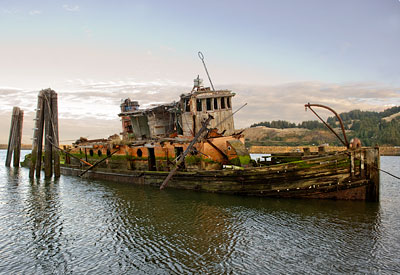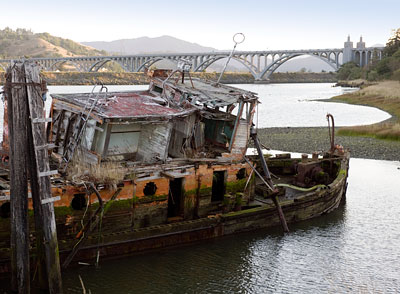National Register of Historic Places in Curry County
Mary D. Hume Coastal Steamer
Port of Gold Beach
Gold Beach
The following narrative is based upon interpretative placards at the site:
In 1876, R. D. Hume of Astoria, Oregon, relocated his salmon fishing, processing and shipping business to the mouth of the Rogue River to take advantage of the annual spawning migration of king salmon from the Pacific to their birthplace in the river.
Four years later, when his small steamer Varuna was destroyed on a bar in the river, Hume salvaged the steam engine. He located a 141 foot white cedar thirteen miles upriver and had it felled and floated downriver to a location less than two hundred feet from where the Mary D. Hume now rests. The trunk of the cedar was used to build the keel and the curved cedar roots were used for ribs. Myrtlewood dowels joined the ribs to the keel.
The vessel, named Mary Duncan Hume after the owner's wife, was launched on 21 January 1881 to begin ninety-seven years of active commercial sea service, the longest for any commercial vessel on the west coast.
She spent her first ten years as a coastal freighter hauling wood, canned salmon and other cargo from Oregon to San Francisco. In late 1899, she was sold to the Pacific Whaling Company for $25,000 and steamed north to the Bering Sea for a decade as an arctic whaling vessel. Her most notable expedition lasted six years, the lengthiest recorded arctic whaling voyage. After surviving a severe storm in 1899, she settled down to towing service in Alaska's Nushagak River.
In 1909,The American Tug Boat Company purchase her and configured her as an ocean tugboat. Except for a brief stint in the Alaska halibut industry, she remained an ocean tugboat until she retired in 1978 and, like countless salmon and steelhead before her, returned from the open ocean to the river where she was born.

